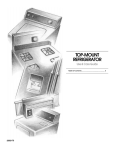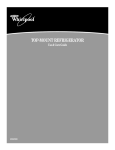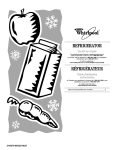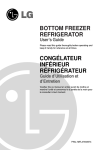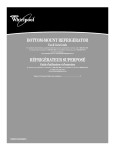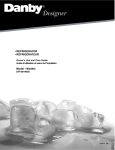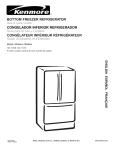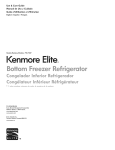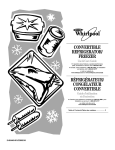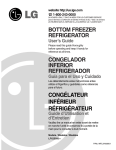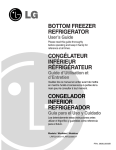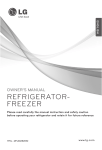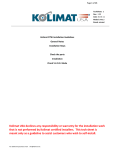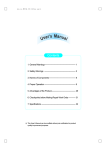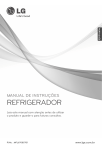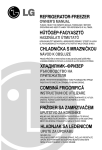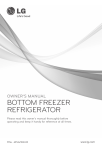Download FRENCH DOOR REFRIGERATOR
Transcript
ENGLISH OWNER’S MANUAL FRENCH DOOR REFRIGERATOR Please read this owner's manual thoroughly before operating and keep it handy for reference at all times. P.No.: MFL68680403 www.lg.com SAFETY MESSAGES BASIC SAFETY PRECAUTIONS This guide contains many important safety messages. Always read and obey all safety messages. This is the safety alert symbol. It alerts you to safety messages that inform you of hazards that can cause death or serious personal injury or cause damage to the product. All safety messages will be preceded by the safety alert symbol and the hazard signal word DANGER, WARNING, CAUTION. These words mean: DANGER WARNING CAUTION All safety messages will identify the hazard, tell you how to reduce the chance of injury, and tell you what can happen if the instructions are not followed. DANGER: RISK OF CHILD ENTRAPMENT BEFORE YOU THROW AWAY YOUR OLD REFRIGERATOR OR FREEZER Child entrapment and suffocation are not problems of the past. Junked or abandoned refrigerators are still dangerous…even if they will sit for just a few days. If you are getting rid of your old refrigerator, please follow the instructions at right to help prevent accidents. • Take off the doors. • Leave the shelves in place so that children may not easily climb inside. CFC DISPOSAL Your old refrigerator may have a cooling system that used CFCs (chlorofluorocarbons). CFCs are believed to harm stratospheric ozone. If you are throwing away your old refrigerator, make sure the CFC refrigerant is removed for proper disposal by a qualified servicer. If you intentionally release this CFC refrigerant, you can be subject to fines and imprisonment under provisions of environmental legislation. 3 GROUNDING REQUIREMENTS IMPORTANT: Please read carefully. TO CONNECT ELECTRICITY It is recommended that a separate circuit serving only this appliance be provided. Do not use an extension cord.Where a standard two-prong wall outlet is encountered, it is your personal responsibility and obligation to have it replaced with a properly grounded three-prong wall outlet. Do not, under any circumstances, cut or remove the third (ground) prong from the power cord. WARNING Electrical Shock Hazard FOR PERSONAL SAFETY, this appliance must be properly grounded. Have the wall outlet and the circuit checked by a qualified electrician to make sure the outlet is properly grounded. NOTE: Before performing any type of installation, cleaning,or removing a light bulb, turn the control (Thermostat, Refrigerator Control or Freezer Control, depending on the model)to OFF and then disconnect the refrigerator from the electrical source. When you are finished,reconnect the refrigerator to the electrical source and reset the control (Thermostat, Refrigerator Control or Freezer Control, depending on the model) to the desired setting. RECOMMENDED GROUNDING METHOD The refrigerator should always be plugged into its own individual properly grounded electrical outlet rated for 240 Volts, 50 Hz, AC only, and fused at 15 amperes. This provides the best performance and also prevents overloading house wiring circuits which could cause a fire hazard from overheated wires. WARNING • Do not use electrical appliances inside the food storage compartments of the appliance, unless they are of the type recommended by the manufacturer. • The refrigerant and insulation blowing gas used in the appliance require special disposal procedures. When disposal, please consult with service agent or a similarly qualified person. • Repair or replace immediately all electric service cords that have become frayed or otherwise damaged. Do not use a cord that shows cracks or abrasion damage along its length or at either the plug or connector end. • When moving your refrigerator away from the wall, be careful not to roll over or damage the power cord. • Keep fingers out of pinch point areas; clearances between the doors and cabinet are necessarily small. Be careful closing doors when children are in the area. • This refrigerator must be properly installed in accordance with the Attention Installer Instructions that were taped to the front of the refrigerator. • Don’t touch the lamp, in case of light on the long time, Because it can be very hot. • DO NOT refreeze frozen foods which have thawed completely. The United States • Keep ventilation openings, in the appliance enclosure or in the built-in structure, clear of obstruction. • Do not use mechanical devices or other means to accelerate the defrosting process,other than those recommended by the manufacturer. • Do not damage the refrigerant circuit. This appliance contains a small amount of isobutane refrigerant (R600a), natural gas with high environmental compatibility, but it is also combustible. When transporting and installing the appliance, care should be taken to ensure that no parts of the refrigerating circuit are damaged. Refrigerant squirting out of the pipes could ignite or cause an eye injury. If a leak is detected, avoid any naked flames or potential sources of ignition and air the room in which the appliance is standing for several minutes. In order to avoid the creation of a flammable gas air mixture if a leak in the refrigerating circuit occurs, the size of the room in which the appliance may be sited depends on the amount of refrigerant used. The room must be 1 in size for every 8g of R600a refrigerant inside the appliance. The amount of refrigerant in your particular appliance is shown on the identification plate inside the appliance. Never start up an appliance showing any signs of damage. If in doubt, consult your dealer. SAVE THESE INSTRUCTIONS 4 IMPORTANT SAFETY INSTRUCTIONS Don’t use an extension cord If possible, connect the refrigerator to its own individual electrical outlet to prevent it and other appliances or household lights from causing an overload that could cause a power outage. Accessibility of Supply Plug The refrigerator-freezer should be so positioned that the supply plug is accessible for quick disconnection should an accident happen. Supply Cord Replacement If the supply cord is damaged, it must be replaced by the manufacturer or its service agent or a similarly qualified person in order to avoid a hazard. • If water pressure does not reach the rating 147 kPa (1.5 kgf/cm2) or below, it is necessary to purchase a separate pressure pump for normal automatic icing and cool water feed. • Keep the total length of the feed water pipe tube within 8 m and be careful for the tube not be bent. If the tube is 8 m or longer it may cause trouble in water feed owing to the drain water pressure. • Install the feed water pipe tube at a place free from heat. WARNING • Connect to potable water supply only. • Refer to instructions with water filter kit for installation. WARNING • The refrigerant and insulation blowing gas used in the appliance require special disposal procedures. When disposal, please consult with service agent or a similarly qualified person. WARNING • Please do not use a dishwasher to clean the lower drawers; the high temperature may cause damage to the baskets which make them unusable. FEED WATER PIPE INSTALLATION Before installation • Automatic ice maker can be installed only by manufacturer. • Automatic ice maker operation needs water pressure of 147~834 kPa (1.5~8.5 kgf/cm2) (That is, an instant paper cup (180 cc) will be fully filled within 3 sec.). WARNING 1. When connecting the power A dedicated outlet should be used. Do not allow the power plug to face upward or to be crushed at the back of the refrigerator. • Using several devices at one outlet may cause fire. • If unit is connected to an earth leakage breaker it may trip resulting in spoiled food. This could occur due to power supply circumstances, and may not necessarily mean a refrigerator malfunction. Prevent the power cord from being squeezed or imprinted if the refrigerator is pushed in after the power plug is extracted during the installation. When moving your appliance away from the wall, be careful not to roll over the power cord or to damage it in any way. It becomes the cause of fire or electric shock. Do not allow the power cord to be bent or crushed by the heavy objects. It may damage the power cord to cause fire or shock. 5 WARNING Do not extend or modify the length of the power plug. When disposing the refrigerator, contact your local City Council. It can cause electric shock or fire by from incorrect installation or unsafe connection. Your local Council can offer disposal options and advise the best method of disposal. Do not pull out the cord or touch the power plug with wet hands. It may cause electric shock or injury. Remove water or dust from the power plug and insert it with the ends of the pins securely connected. Make sure of grounding. Dust, water or unstable connection may fire or electric shock. Consult a qualified electrician or service person if the grounding instructions are not completely understood, or if you have doubts on whether the appliance is properly grounded. The incorrect grounding Grounding may cause breakdown Conductor and electric shock. Copper flat Do not move refrigerator while the compressor is operating. compressor may occur a temporary rattling noise. (This is normal and will not impact on the performance or the life of the compressor.The rattling will stop after the refrigerator comes to a rest.) More than 75cm If a gas leak is detected, do not touch the compressor is operating . When the power cord or the power plug is damaged or the power the outlet is loose or damaged, do not plug the power cord into the outlet. Any spark my result in an explosion or fire. Because this refrigerator uses natural gas (isobutene, R600a ) as the environment-friendly refrigerant, even a small amount (80-90g) is combustible. If a gas leak occurs due to severe damage during delivery , installation or a sealed system malfunction, a speak may causes fire (only for the model with the R600a.) Doing so may cause electric shock or be the cause of a fire. Unplug the power plug when cleaning, handling or replacing the interior lamp of the refrigerator Unplug the power cord from the power outlet for cleaning or other requirements. • Not doing so may cause electric shock or injury. • When replacing the interior lamp of the refrigerator, make sure that the insulating rubber ring within the socket is not taken off. • Not doing so may cause electric shock or injury. 6 IMPORTANT SAFETY INSTRUCTIONS 2. When using the refrigerator Do not damage the sealed system or any piping in or within the refrigerator. Do not place the dangerous item, or heavy objects(including containers with liquid ) on the refrigerator. The may fall or spill and cause injury, fire or electric shock when opening or closing the door. Take care when opening and closing the refrigerator doors. Vigorous opening or closing may cause the contents to topple out resulting in injury or damage. It may cause explosion or fire. dicine The Me A health risk Could occur if connected to nor drinkable water. 7 Ether The Academic Medicine Thinner Do not use the combustible spray near the refrigerator. Do not store explosive substances such as aerosol cans with a flammable propellant in this appliance. It may cause explosion or fire. Supply the refrigerator with drinkable water only (only for the model Drinkable water with the dispenser). Benzene It may cause explosion or fire. IMPORTANT SAFETY INSTRUCTIONS Thinner When any burning smell or smoke is detected from the refrigerator, disconnect the power plug immediately and contact to the Service manufacturer or an center authorised service provider. Do not allow any person except the qualified engineer to disassemble, repair or alter the refrigerator. It may cause injury, electric shock or fire. Install the refrigerator on a solid and level floor. This appliance is not intended for use by persons (including children) with reduced physical, sensory or mental capabilities, or lack of experience and knowledge, unless they have been given supervision or instruction concerning use of the appliance by a person responsible for their safety. Installing it in an unstable place may cause death by falling over the refrigerator when opening or closing the door. Children should be supervised to ensure that they do not play with the appliance. It is recommended that the refrigerator be dusconnected during severe electrical storms or if not in use for long periods. 8 CAUTION Do not insert the hands into the ice bucket or the ice dispenser. Do not touch food or containers in the freezer with wet hands. Operating the ice maker may cause injury. It may cause frostbite. Do not put filled bottles in the freezer. This will freezer the contents and break the bottle to possibly resulting in injury. Pull out the power plug not by grasping the plug , not the cord. of its end. Do not place the food in disorder inside the refrigerator. The food may fall during opening and closing the door of the refrigerator and hurt people. Not doing so can cause electric shock ,short circuit or fire. If the mains plug is removed from the wall outlet for any reason,wait for 5 minutes or longer before reconnecting the plug. Not doing so may cause the operation of the refrigerator to fail. Carry the fridge-freezer with the handles at the bottom of the front and the top of the rear. Do not put any living animal or non edible plants in the refrigerator. 9 PARTS AND FEATURES A K L B B H C I D J E F G Use this page to become more familiar with the parts and features.Page references are included for your convenience. NOTE: This guide covers several different models. The refrigerator you have purchased may have some or all of the items listed below. The locations of the features shown below may not match your model. A Digital Sensor Control G Ice Bin B Modular Door Bins H Pull out Drawer C Shelves I Durabase D Crisper (Keeps fruits and vegetable fresh and crisper) J Divider K Dairy Bin E Glide’N’Serve L M Mullion F Automatic Icemaker 10 REFRIGERATOR INSTALLATION INSTALLATION WARNING • To minimize noise and vibration, the refrigerator MUST be installed on a solidly constructed floor. • Carpeting and soft tile surfaces are not recommended. • Never install the refrigerator on a platform or weakly supported structure. 1. To avoid vibration, the unit must be level. If required, adjust the leveling screws to compensate for unevenness of the floor. The front should be slightly higher than the rear to aid in door closing. Leveling screws can be turned easily by tipping the cabinet slightly. Turn the leveling screws clockwise ( ) to raise the unit, counterclockwise ( ) to lower it. 2. Install this appliance in an area where the temperature is between 13°C and 43°C. If the temperature around the appliance is too low or high, cooling ability may be adversely affected. 3. Too small a distance from adjacent items may result in lowered freezing capability and increased electricity consumption charges. Allow at least 24" (61 cm) in front of the refrigerator to open the doors. Excessive Weight Hazard Use two or more people to move and install refrigerator. Failure to do so can result in back or other injury. UNPACKING YOUR REFRIGERATOR Remove tape and any temporary labels from your refrigerator before using. Do not remove any warning-type labels, the model and serial number label, or the TechSheet that is attached to back wall of the refrigerator. To remove any remaining tape or glue, rub the area briskly with your thumb. Tape or glue residue can also be easily removed by rubbing a small amount of liquid dish soap over the adhesive with your fingers. Wipe with warm water and dry. Do not use sharp instruments, rubbing alcohol, flammable fluids or abrasive cleaners to remove tape or glue. These products can damage the surface of your refrigerator. For more information, see the Important Safety Instructions section. Refrigerator shelves are installed in the shipping position. Please reinstall shelves according to your individual storage needs. WARNING 2" (5.08 cm) When Moving Your Refrigerator: NEXT Your refrigerator is heavy. When moving the refrigerator for cleaning or service, be sure to protect the floor. Always pull the refrigerator straight out when moving it. Do not wiggle or walk the refrigerator when trying to move it, as floor damage could occur. 1. Clean your refrigerator thoroughly and wipe off all dust accumulated during shipping. 2. Install accessories such as ice cube bin, drawers, shelves, etc., in their proper places. They are packed together to prevent possible damage during shipment. 3. Let your refrigerator run for at least 2 or 3 hours before putting food in it. Check the flow of cold air in the freezer compartment to ensure proper cooling. Your refrigerator is now ready for use. WARNING Explosion Hazard BASE COVER Keep flammable materials and vapors, such as gasoline, away from refrigerator. Failure to do so can result in death, explosion or fire. To remove the base cover 1. Open the Freezer Drawer. (Drawer not shown for clarity.) 2. Once drawer is open there is sufficient clearance to remove screws on top of cover. To replace base cover: • Place cover into position and insert and tighten screws. • To reduce the risk of electric shock, do not install the refrigerator in a wet or damp area. • Select a place where a water supply can be easily connected for the automatic icemaker. w CAUTION: Avoid placing the unit near heat sources, direct sunlight or moisture. 11 REMOVING AND REPLACING YOUR REFRIGERATOR HANDLES AND DOORS HOW TO REMOVE DOOR HANDLES To move refrigerator through a house door, it maybe necessary to remove refrigerator and freezer door handles. NOTE: Handle appearance may vary from illustrations on this page. Mounting Fasteners 1. Removing Refrigerator Handle • Loosen the set screws with the 3/32" (2.4mm) Allen wrench and remove the handle. NOTE: If the handle mounting fasteners need to be tightened or Set Screw removed, use a 1/4" (6.4mm) Allen wrench. Allen Wrench 2. Removing Freezer Drawer Handle • Loosen the set screws located on the lower side of the handle with the 1/8" (3.2mm) Allen wrench and remove the handle. NOTE: If the handle mounting fasteners need to be tightened or removed, use a 1/4" (6.4mm) Allen wrench. 12 REFRIGERATOR INSTALLATION HOW TO REPLACE DOOR HANDLES NOTE: Handle appearance may vary from illustrations on this page. 1. Replacing Refrigerator Door Handle • Place the handle on the door by adjusting handle footprints to fit mounting fastners and tighten the set screws with the 3/32" (2.4mm) Allen wrench. NOTE: If the handle mounting fasteners need to be tightened or removed use a 1/4" (6.4mm) Allen wrench. Mounting Fasteners 2. Replacing Freezer Drawer Handle • Place the handle on the door by adjusting handle footprints to fit mounting fastners and tighten the set screws on the bottom of the handle with a 1/8" (3.2mm) Allen wrench. NOTE: If the handle mounting fasteners need to be tightened or removed use a 1/4" (6.4mm) Allen wrench. w WARNING When the customer takes apart the handle or assemble it from a refrigerator, please be cautious of following things. • Hold the handle with your own hand to make sure not to drop the handle to the floor or instep while taking apart the handle from a refrigerator. • Do not swing the handle towards people or animals after taking apart the handle. • Insert the bracket hole of the handle into the stopper bolt of the door exactly, and then assemble the set screws to fix the handle. • Check if there's any gap between the door and handle after fixing the handle. 13 REFRIGERATOR INSTALLATION HOW TO REMOVE REFRIGERATOR DOOR 1. Removing Refrigerator Door NOTE: Handle appearance may vary. IMPORTANT: Before you begin, turn the refrigerator OFF and unplug it. Remove food and any bins from doors. (1) (2) (2) (1) (3) (4) (5) (6) (4) (5) (3) (7) 1. To remove the left refrigerator door: 2. To remove the right refrigerator door: • Open the door. Remove the top hinge cover screw (1). • Use a flat blade screwdriver to lift the tabs on the front underside of the cover(2). Lift up the cover. • Rotate hinge lever (3) clockwise. Lift the top hinge (4) free of the hinge lever latch (5). IMPORTANT: When lifting the hinge free of the latch, be careful that the door is heavy and may fall forward. • Lift the door from the middle hinge pin and remove the door. • Place the door, inside facing up, on a nonscratching surface. • Open the door. Remove the top hinge cover screw (1). • Use a flat blade screwdriver to lift the tabs on the front underside of the cover(2). Lift up the cover. • Disconnect all the wire harnesses (3). • Remove the grounding screw(4). • Rotate hinge lever (5) counterclockwise. Lift the top hinge (6) free of the hinge lever latch (7). IMPORTANT: When lifting the hinge free of the latch, be careful that the door does not fall forward. • Lift the door from the middle hinge pin and remove the door. • Place the door, inside facing up, on a nonscratching surface. 14 REFRIGERATOR INSTALLATION 2. Replacing Refrigerator Door (4) (1) (2) (3) Install the right-side door first. • Lower the door onto the middle hinge pin as shown. • Make sure the plastic sleeve is inserted in the bottom of the door. 2 • Fit the top hinge (1) over the hinge lever latch (2) and into place. Rotate the lever (3) counterclockwise to secure the hinge. • Insert and tighten the cover screw (4). (2) (4) (5) (1) (3) • Fit the top hinge (1) over the hinge lever latch (2) and into place. Rotate the lever (3) clockwise to secure the hinge. • Install the grounding screw (4) and connect all the wire harnesses (5). Install the left-side door. • Lower the door onto middle hinge pin. 15 REFRIGERATOR INSTALLATION HOW TO REMOVE AND INSTALL THE PULLOUT DRAWER • With both hands, hold both sides of the door and pull it up to separate it from the rails. IMPORTANT: To avoid possible injury or product or property damage, you will need two people to perform the following instructions. 1. Removing Pullout Drawer • Pull the drawer open to full extension. Remove the lower basket (1) by lifting basket from rail system. (If you tilt the door, it will be easier.) • With both hands, hold the center bar and push it in to let both rails fitted simultaneously. • Press both hangers with your thumbs to lift it up. • Separate the left and right rail cover. CAUTION: When you remove the drawer, do not hold the handle. If it may come off and it could cause personal injury. • Remove the screws (2) of the rail on both sides. CAUTION: When laying the drawer down, be careful not to damage the floor or hurt your feet by the sharp edges on hinge side. 16 REFRIGERATOR INSTALLATION HOW TO REMOVE AND INSTALL THE PULLOUT DRAWER IMPORTANT: To avoid possible injury or product or property damage, you will need two people to perform the following instructions. 2. Installing Pullout Drawer • Align the top holes of the rail cover with the top holes of the door supports to assemble the rail covers. • With both hands, hold the center bar and push it out to let both rails out to full extension simultaneously. Right Rail Cover Assembly Hole Left Rail Cover • With the drawer pulled out to full extension, insert the lower basket (4) in the rail assembly. • Hook door supports (1) into rail tabs (2). 1 2 • Lower door into final position and tighten the screws (3). WARNING: To prevent accidental child and pet entrapment or suffocation risk. DO NOT allow them to play inside of drawer. WARNING: DO NOT step or sit down on freezer door. 17 REFRIGERATOR INSTALLATION LEVELING AND DOOR ALIGNMENT Door Alignment Leveling After installing, secure the product with the LEG not to move left or right. Your refrigerator has two front leveling screws— one on the right and one on the left. If your refrigerator seems unsteady or you want the doors to close easier, adjust the refrigerator’s tilt using the instructions below: 1. Plug the refrigerator’s power cord into a 3-prong grounded outlet. Move the refrigerator into its final position. 2. Turn the leveling leg clockwise to raise that side of the refrigerator or counterclockwise to lower it. It may take several turns of the leveling leg to adjust the tilt of the refrigerator. NOTE: Having someone push against the top of the refrigerator takes some weight off the leveling legs. This makes it easier to adjust the legs. Both the left and right refrigerator doors have an adjustable nut, located on the bottom hinge, to raise and lower them to align properly. If the space between your doors is uneven, follow the instructions below to align the doors evenly: Use the wrench to turn the nut in the door hinge to adjust the height. To the right to raise or to the left to lower the height. 3. Open both doors again and check to make sure that they close easily. If not, tilt the refrigerator slightly more to the rear by turning both leveling screws clockwise. It may take several more turns, and you should turn both leveling screws the same amount. 4. Re-adjust if necessary. 5. Replace the base cover. NOTE: Your new refrigerator is uniquely designed with two fresh food doors. Either door can be opened or closed independently of one another. You may have to exert slight pressure on doors to get them to close completely. 18 USING YOUR REFRIGERATOR ENSURING PROPER AIR CIRCULATION • Initially set the Fridge control at 3°C and the Freezer control at –18°C. Leave it at this setting for 24 hours (one day) to stabilize. Then adjust the compartment temperature as desired. • Freezer control: –21°C to –13°C When the setting is at a lower number, the freezer compartment becomes colder. But the refrigerator compartment becomes warmer because less cold air flows into the refrigerator. In order to ensure proper temperatures, air must flow between the refrigerator and freezer sections. As shown in the illustration below, air enters at top of freezer and circulates down. From bottom of freezer, air is forced up to top of refrigerator. Air enters refrigerator through top vent, then circulates and exists at bottom, where it returns to freezer. MULTI-FLOW • Multi-Flow means powerful and effective cooling operation. This is especially noticeable when new food is placed in the refrigerator compartment. • Fridge control: 1°C to 8°C The lower the number setting, the colder the refrigerator compartment will become. • Express Freeze: Press the Express Freeze key and the LED will turn on. This function will remain activated for 24 hours and intensify the cooling speed of freezer and increase the amount of ice. • If water or foreign substances enter the cool air vent while cleaning, efficiency will be lowered. In addition, if gasket is damaged, efficiency may be lowered because of escaping cool air. • Door Alarm When the power is connected to the refrigerator, door alarm is initially set "ON" and door alarm display will show Door Alarm "ON". When either refrigerator or the freezer door is left open for more than 60 seconds, the alarm will ding to let you know the door is open. When you close the door, the door alarm will stop dinging. If you want to disable the door alarm function, press Door Alarm button then the door alarm display will switched to Door Alarm "OFF". Do not block any of cool air vents with food packages. If the vents are blocked, airflow will be interrupted and temperature and moisture problems may occur. CAUTION Display Mode (For Store Use Only) The Display Mode disables all cooling in the refrigerator and freezer sections to conserve energy while on display in a retail store. When activated, "OFF" will display on the control panel. To deactivate: Open the Right hand Refrigerator door, then while holding down the Fridge button continuously, touch the Express Freeze button 3 times. The control panel will been and the temperature settings will change to confirm that the Display Mode is deactivated. Use the same procedure to activate the Display Mode. IMPORTANT: Because air circulates between both sections, any odors formed in one section will transfer to the other. You must thoroughly clean both sections to eliminate odors. To prevent odor transfer and drying out of food, wrap or cover foods tightly. SETTING THE CONTROLS • Your refrigerator has two controls that let you regulate the temperature in the freezer and refrigerator compartments. 19 USING YOUR REFRIGERATOR ADJUSTING CONTROL SETTINGS FOOD STORAGE GUIDE Give the refrigerator time to cool down completely before making final adjustments. It is best to wait 24 hours before doing this. The mid-settings indicated in the previous section should be correct for normal household refrigerator usage. The controls are set correctly when milk or juice is as cold as you like and when ice cream is firm. The refrigerator control functions as the thermostat for the entire appliance (refrigerator and freezer sections). The higher the number setting, the longer the compressor will run to keep the temperature colder. The freezer control adjusts the cold air flow from the freezer to the refrigerator. Setting the freezer control to a lower temperature keeps more cold air in the Freezer compartment to make it colder. If you need to adjust temperatures in the refrigerator or freezer, start by adjusting the refrigerator. Then wait 24 hours before checking the freezer temperature. If it is too warm or too cold, then adjust the freezer control. Use the settings listed in the chart below as a guide. Always remember to wait at least 24 hours between adjustments. Wrap or store food in the refrigerator in airtight and moisture-proof material unless otherwise noted. This prevents food odor and taste transfer throughout the refrigerator. For dated products, check date code to ensure freshness. CONDITION/ REASON: RECOMMENDED ADJUSTMENT: Fridge section too warm – Door opened often – Large amount of food added – Room temperature very warm Set Fridge control to next lower number, wait 24 hours, then re-check Freezer section too warm/ice not made fast enough – Door opened often – Large amount of food added – Very cold room temperature (can’t cycle often enough) – Heavy ice usage – Air vents blocked by items Set Freezer control to next lower number, wait 24 hours, then re-check Fridge section too cold – Controls not set correctly for your conditions Set Fridge control to next higher number, wait 24 hours, then re-check Freezer section too cold – Controls not set correctly for your conditions Items Move items out of airstream Set Freezer control to next higher number, wait 24 hours, then re-check 20 How to Butter or margarine Keep opened butter in a covered dish or closed compartment. When storing an extra supply, wrap in freezer packaging and freeze. Cheese Store in the original wrapping until you are ready to use it. Once opened, rewrap tightly in plastic wrap or aluminum foil. Milk Wipe milk cartons. For best storage, place milk on interior shelf, not on door shelf. Eggs Store in original carton or Utility Bin on interior shelf, not on door shelf. Fruit Wash, let dry, and store in refrigerator in plastic bags or in the crisper. Do not wash or hull berries until you are ready to use them. Sort and keep berries in their original container in a crisper, or store in a sloosely closed paper bag on a refrigerator shelf. Leafy vegetables Remove store wrapping and trim or tear off bruised and discolored areas. Wash in cold water and drain. Place in plastic bag or plastic container and store in crisper. Vegetables with skins (carrots, peppers) Place in plastic bags or plastic container and store in crisper. Fish Use fresh fish and shellfish the same day purchased. Leftovers Cover leftovers with plastic wrap or aluminum foil. Plastic containers with tight lids can also be used. USING YOUR REFRIGERATOR STORING FROZEN FOOD Freezing NOTE: For further information about preparing food for freezing or food storage times, check a freezer guide or a reliable cookbook. Your freezer will not quick-freeze any large quantity of food. Do not put more unfrozen food into the freezer than will freeze within 24 hours. Leave enough space in the freezer for air to circulate around packages. Be careful to leave enough room at the front so the door can close tightly. Packaging Successful freezing depends on correct packaging. When you close and seal the package, it must not allow air or moisture in or out. If it does, you could have food odor and taste transfer throughout the refrigerator and also dry out frozen food. Storage times will vary according to the quality and type of food, the type of packaging or wrap used (airtight and moisture-proof) and the storage temperature. Ice crystals inside a sealed package are normal. This simply means that moisture in the food and air inside the package have condensed, creating ice crystals. Packaging recommendations: • Rigid plastic containers with tight-fitting lids NOTE: Allow hot foods to cool at room temperature for 30 minutes, then package and freeze. Cooling hot foods before freezing saves energy. • Straight-sided canning/freezing jars • Heavy-duty aluminum foil • Plastic-coated paper • Non-permeable plastic wraps • Specified freezer-grade self-sealing plastic bags Follow package or container instructions for proper freezing methods. Do not use • Bread wrappers • Non-polyethylene plastic containers • Containers without tight lids • Wax paper or wax-coated freezer wrap • Thin, semi-permeable wrap w CAUTION : Do not keep beverage cans or plastic food containers in the freezer compartment. They may be break if they freezer. 21 USING YOUR REFRIGERATOR REFRIGERATOR SECTION CAUTION : Make sure that shelves are level from one side to the other. Failure to do so may result in the shelf falling or spilling food. REFRIGERATOR SHELVES The shelves in your refrigerator are adjustable to meet your individual storage needs. Your model may have glass or wire shelves. Sliding Out Shelves Storing similar food items together in your refrigerator and adjusting the shelves to fit different heights of items will make finding the exact item you want easier; it will also reduce the amount of time the refrigerator door is open, saving energy. • To slide the shelf out, carefully pull front of shelf toward you. You can slide glass shelves in and out of your refrigerator as follows. • To slide shelf in, push shelf in until it stops. IMPORTANT: Do not clean glass shelves with warm water when they are cold. Shelves may break if exposed to sudden temperature changes or impact, such as bumping. For your protection, glass shelves are made with tempered glass, which will shatter into small pebble-sized pieces. NOTE: Glass shelves are heavy. Use special care when removing them to avoid dropping them. Adjusting Shelves Remove shelves from the shipping position and replace shelves in the position you want. • To remove a shelf—Tilt up the front of the shelf in the direction of (1) and lift it in the direction of (2). Pull the shelf out. • To reinstall a shelf—Tilt the front of the shelf up and guide the shelf hooks into the slots at a desired height. Then lower the front of the shelf so that the hooks drop into the slots. 22 USING YOUR REFRIGERATOR CRISPER HUMIDITY CONTROL GLIDE‘N’SERVE You can control the amount of humidity in the moisture-sealed crispers. Store vegetables or fruits requiring more or less humidity in separate crispers. Adjust the control to any setting between High and Low. • Low lets moist air out of the crisper for best storage of fruits. • High keeps moist air in the crisper for best storage of fresh, leafy vegetables. The Glide‘N’Serve provides storage space with a variable temperature control that keeps the compartment colder than refrigerator. This drawer can be used for large party trays, deli items, or beverages. (but this drawer can't be used for vegetable.) ol ntr Low Colder l tro w Lo on yC it mid Hu ht Hig Cold Humidity Control High Low Controls The control regulates the air temperature in the drawer. Set control level to Cold (print on surface) to provide normal refrigerator temperature. Use the Colder (print on surface) setting for meats or other deli items. NOTE: Cold air directed to the Glide‘N’Serve can decrease refrigerator temperature. Refrigerator control may need to be adjusted. CAUTION : The glass shelf over the crisper is not firmly secured. Be careful when tilting. REMOVING CRISPER 1. To remove, pull the drawer out to full extension. 2. Lift the front of the crisper up, then pull it straight out. 3. To install, slightly tilt up the front and insert the drawer into the frame and push it back into place. To replace Glide‘N’Serve 1 1. To remove, pull the drawer out to full extension. 2. Lift the front of the drawer up, then pull it straight out. 3. To install, slightly tilt up the front and insert the drawer into the frame and push it back into place. To remove the glass 1. Lift up the glass under the crisper cover. 2. Pull the glass up and out. 23 USING YOUR REFRIGERATOR MODULAR DOOR BIN FREEZER SECTION The door bins are removable for easy cleaning and adjusting. ICE BIN 1. To remove the bin, simply lift the bin up and pull straight out. 1. To separate the ice bin, pull out the drawer as much as possible. 2. Gently lift and pull out the ice bin. 2. To replace the bin, slide it in above the desired support button and push down until it stops. 3. To install, pull out the drawer as much as possible and set the ice bin in its correct position, then push in the drawer. DRAWER WARNING : Somebody can be hurt if door bins are not firmly assembled. ICE BIN NOTE : DO NOT adjust a bin that is loaded with food. CAUTION : DO NOT allow children to play with baskets. Sharp corners on baskets could cause injury. DAIRY BIN 1. To remove the dairy bin, simply lift it and pull straight out. 2. To replace the dairy bin, slide it in above the desired location and push down until it stops. 24 USING YOUR REFRIGERATOR DURABASE DURABASE DIVIDER 1. To remove the Durabase, push it back to the end as much as possible. Tilt up the front of the Durabase and pull straight out. The Durabase divider allows you to organize the Durabase area into sections. 2. To install, insert the Durabase in rail assembly. 1 2 WARNING : If the Durabase divider is removed, there is enough open space for children or pets to crawl inside. To prevent accidental child and pet entrapment or suffocation risk, DO NOT allow them to play inside of drawer. PULL OUT DRAWER To remove the drawer, push the tabs located on the front inside surface of each rail. Next, gently lift the rear left and right sides of the drawer and pull it out. Bracket To reinstall, pull out both rails to full extension. Insert the end of rib in the bracket at left and right. Making sure that the guides at the front are lined up properly, gently push down on both sides. 25 CARE AND CLEANING PLASTIC PARTS (covers and panels) WARNING Do not use window sprays, abrasive cleansers, or flammable fluids. These can scratch or damage the material. Rear Vent Use a vacuum cleaner with an extended attachment to clean Rear Vent.Vacuum vent when dusty or dirty.vent may need to be cleaned as often as every other month. Explosion Hazard Use non-flammable cleaner. Failure to do so can result in death, explosion, or fire. Both the refrigerator and freezer sections defrost automatically. However,clean both sections about once a month to prevent odors. Wipe up spills immediately. GENERAL CLEANING TIPS • Unplug refrigerator or disconnect power. • Remove all removable parts, such as shelves, crispers, etc. Refer to sections in Using Your Refrigerator for removal instructions. • Use a clean sponge or soft cloth and a mild detergent in warm water.Do not use abrasive or harsh cleaners. • Hand wash, rinse and dry all surfaces thoroughly. • Plug in refrigerator or reconnect power. OUTSIDE Waxing external painted metal surfaces helps provide rust protection. Do not wax plastic parts. Wax painted metal surfaces at least twice a year using appliance wax (or auto paste wax). Apply wax with a clean, soft cloth. For products with a stainless steel exterior, use a clean sponge or soft cloth and a mild detergent in warm water. Do not use abrasive or harsh cleaners. Dry thoroughly with a soft cloth. INSIDE WALLS (allow freezer to warm up so cloth won’t stick) To help remove odors, you can wash the inside of the refrigerator with a mixture of baking soda and warm water. Mix 2 tablespoons baking soda to 1 quart of water (26 g soda to 1 liter water.) Be sure the baking soda is completely dissolved so does it not scratch the surfaces of the refrigerator. CAUTION: While cleaning the inside, do not spray water. DOOR LINERS AND GASKETS Do not use cleaning waxes, concentrated detergents, bleaches, or cleaners containing petroleum on plastic refrigerator parts. 26 CARE AND CLEANING POWER INTERRUPTIONS WHEN YOU MOVE 1. If the power will be out for 24 hours or less, keep all refrigerator doors closed to help foods stay cold and frozen. When you are moving your refrigerator to a new home, follow these steps to prepare it for the move. 2. If the power will be out for more than 24 hours: 1. Remove all food from the refrigerator and pack all frozen food in dry ice. a) Remove all frozen food and store it in a frozen food locker. 2. Depending on your model, turn the thermostat control (refrigerator control) to "OFF". See the Setting the Controls section. WHEN YOU GO ON VACATION If you choose to leave the refrigerator on while you are away, follow these steps to prepare your refrigerator before you leave. 3. Unplug the refrigerator. 4. Clean, wipe and dry thoroughly. 5. Take out all removable parts, wrap them well and tape them together so they don’t shift and rattle during the move. Refer to sections in Using your Refrigerator for removal instructions. 1. Use up any perishables and freeze other items. 2. Empty the ice bin. If you choose to turn the refrigerator off before you leave, follow these steps. 6. Depending on the model, raise the front of the refrigerator so it rolls more easily OR screw in the leveling legs all the way so they don’t scrape the floor. See the Door Closing section. 1. Remove all food from the refrigerator. 2. Depending on your model, set the thermostat control (refrigerator control) to "OFF" . See the Setting the Controls section. 7. Tape the doors shut and tape the power cord to the refrigerator cabinet. 3. Clean refrigerator, wipe it and dry well. 4. Tape rubber or wood blocks to the tops of both doors to prop them open far enough for air to get in. This stops odor and mold from building up. When you get to your new home, put everything back and refer to the Installing Your Refrigerator section for preparation instructions. 27 1_MFL37933573_Eng 2010.5.3 6:38 PM 페이지28 ABOUT THE AUTOMATIC ICEMAKER WHEN YOU SHOULD SET THE ICEMAKER POWER SWITCH TO O (OFF) w WARNING Personal Injury Hazard OPERATION INSTRUCTIONS • When the water supply will be shut off for several hours. • When the ice bucket is removed for more than a minute or two. • When the refrigerator will not be used for several days. A newly-installed refrigerator may take 12 to 24 hours to begin making ice. NORMAL SOUNDS YOU MAY HEAR DO NOT insert your hands in to the Icemaker in operation. It may cause to injure you. Automatic Shut off Arm • The icemaker water valve will buzz as the icemaker fills with water. If the power switch is in the I (on) position, it will buzz even if it has not yet been hooked up to water. To stop the buzzing, move the power switch to O (off). NOTE: Keeping the power switch in the I (on) position before the water line is connected can damage the icemaker. • You will hear the sound of cubes dropping into the bin and water running in the pipes as the icemaker refills. Power Switch The icemaker will produce 12 cubes per cycle— approximately 90–130 cubes in a 24- hour period, depending on freezer compartment temperature, room temperature, number of door openings and other operating conditions. If the refrigerator is used before the water connection is made to the icemaker, set the power switch to O (off). When the refrigerator has been connected to the water supply, set the power switch to I (on). The icemaker will fill with water when it cools to freezing. A newly-installed refrigerator may take 12 to 24 hours to begin making ice cubes. Throw away the first few batches of ice to allow the water line to clear. Be sure nothing interferes with the sweep of the Automatic Shut off Arm. When the bin fills to the level of the Automatic Shut off Arm, the icemaker will stop producing ice. It is normal for several cubes to be stuck together. If ice is not used frequently, old ice cubes will become cloudy, taste stale, and shrink. PREPARING FOR VACATION Set the icemaker power switch to O (off) and shut off the water supply to the refrigerator. If the ambient temperature will drop below freezing, have a qualified servicer drain the water supply system to prevent serious property damage due to flooding from ruptured water lines or connections. 28 CONNECTING THE WATER LINE BEFORE YOU BEGIN CONNECT THE TUBING TO THE REFRIGERATOR This water line installation is not warranted by the refrigerator or icemaker manufacturer. Follow these instructions carefully to minimize the risk of expensive water damage. Water hammer (water banging in the pipes) in house plumbing can cause damage to refrigerator parts and lead to water leakage or flooding. Call a qualified plumber to correct water hammer before installing the water supply line to the refrigerator. To prevent burns and product damage, do not hook up the water line to the hot water line. If you use your refrigerator before connecting the water line, make sure the icemaker power switch is in the O (off) position. Do not install the icemaker tubing in areas where temperatures fall below freezing. Removing and Replacing Valve Cover NOTE: • Before making the connection to the refrigerator, be sure the refrigerator power cord is not plugged into the wall outlet. 1. Remove the plastic flexible cap from the water valve. 2. Place the compression nut and ferrule (sleeve) onto the end of the tubing as shown. 3. lnsert the end of the PVC tubing into the connection as far as possible. While holding the tubing, tighten the fitting. CAUTION: Check to see if leaks occurs at water line connections. BEFORE INSTALLATION Automatic ice maker operation needs water pressure of 147 ~ 834 kPa (1.5 ~ 8.5kgf/cm2) (That is, an instant paper cup (180cc) will be fully filled within 5sec.). Tubing Clamp If water pressure does not reach the rating 147kPa (1.5kgf/cm) or below, it is necessary to purchase a separate pressure pump for normal automatic icing and cool water dispensing. 1/4 " Tubing 1/4 " Compression Nut Ferrule (sleeve) Keep the total length of the feed water pipe tube within 8 m and be careful not to bend sharply or kink tube. If the tube is 8 m or longer it may cause trouble. Refrigerator Connection Ensure the feed water pipe is not installed close to any heat source. WARNING Connect to drinkable water supply only. Refer to instructions with water filter kit for installation. 29 TROUBLESHOOTING GUIDE UNDERSTANDING SOUNDS YOU MAY HEAR • The defrost timer will click when the automatic defrost cycle begins and ends. The thermostat control (or refrigerator control, depending on the model) will also click when cycling on and off. • Rattling noises may come from the flow of refrigerant, the water line, or items stored on top of the refrigerator. • Your refrigerator is designed to run more efficiently to keep your food items at the desired temperature. The high efficiency compressor may cause your new refrigerator to run longer than your old one, and you may hear a pulsating or high-pitched sound. • You may hear the evaporator fan motor circulating the air through the refrigerator and freezer compartments. • As each cycle ends, you may hear a gurgling sound due to the refrigerant flowing in your refrigerator. • Contraction and expansion of the inside walls may cause a popping noise. • Water dripping on the defrost heater during a defrost cycle may cause a sizzling sound. • You may hear air being forced over the condenser by the condenser fan. • You may hear water running into the drain pan during the defrost cycle. Your new refrigerator may make sounds that your old one didn’t make. Because the sounds are new to you, you might be concerned about them. Most of the new sounds are normal. Hard surfaces, like the floor, walls and cabinets, can make the sounds seem louder than they actually are. The following describes the kinds of sounds and what may be making them. Check if… REFRIGERATOR DOES NOT OPERATE Then… The power supply cord is unplugged. A household fuse has blown or circuit breaker tripped. The refrigerator control is set to the OFF position. Refrigerator is in the defrost cycle. Firmly plug the cord into a live outlet with proper voltage. Replace the fuse or reset the circuit breaker. Refer to the Setting the Controls section on page 19. Wait about 30 minutes for defrost cycle to end. VIBRATION OR RATTLING NOISE The refrigerator is not resting solidly on the floor. Floor is weak or uneven or leveling legs need adjusting. See Installation section on page 11. LIGHTS DO NOT WORK The power supply cord is unplugged. Firmly plug the cord into a live outlet with proper voltage. 30 TROUBLESHOOTING GUIDE Check if… COMPRESSOR MOTOR SEEMS TO RUN TOO MUCH Then… The refrigerator that was replaced was an older model. The room temperature is hotter than normal. The door is opened often or a large amount of food has just been added. The refrigerator was recently plugged in and the refrigerator control was set correctly. The refrigerator control is not set correctly for the surrounding conditions. The doors are not closed completely. The condenser coils are dirty. DOORS WILL NOT CLOSE COMPLETELY The refrigerator is not level. Food packages are blocking the door open. The ice bin, crisper cover, pans, shelves, door bins or baskets are out of position. The gaskets are sticking. The refrigerator wobbles or seems unstable. The doors were removed during product installation and not properly replaced. FROST OR ICE CRYSTALS ON FROZEN FOOD The door is not closing properly. The door is opened often. 31 Modern refrigerators with more storage space require more operating time. The motor will run longer under warm conditions. At normal room temperatures, expect your motor to run about 40% to 80% of the time. Under warmer conditions, expect it to run even more often. Adding food and opening the door warms the refrigerator. It is normal for the refrigerator to run longer in order to cool the refrigerator back down. Adding a large amount of food warms the refrigerator. See the Food Storage Guide section on page 20. In order to conserve energy, try to get everything you need out of the refrigerator at once, keep food organized so it is easy to find and close the door as soon as the food is removed. The refrigerator will take up to 24 hours to cool completely. See the Adjusting Control Settings section on page 20. Push the doors firmly shut. If they will not shut all the way, see Doors will not close completely below. This prevents air transfer and makes the motor work harder. Clean the condenser coils. Refer to the Care and Cleaning section on pages 26–27. See Leveling and Door Alignment on page 18. Rearrange food containers to clear door and door shelves. Push bins all the way in and put crisper cover, pans, shelves and baskets into their correct positions. See the Using Your Refrigerator section on pages 19–25. Clean gaskets and the surface that they touch. Rub a thin coat of paraffin wax on the gaskets after cleaning. Level the refrigerator. Refer to the Leveling and Door Alignment section on page 18. Remove and replace the doors according to the Removing and Replacing Refrigerator handles and doors section on pages 12–15, or call a qualified service technician. See Doors will not close completely above. When the door is opened, warm, humid air is allowed in the freezer, resulting in frost. TROUBLESHOOTING GUIDE Check if… ICE HAS OFFTASTE OR ODOR Then… The icemaker was recently installed. The interior of refrigerator needs cleaning. Ice storage bin needs cleaning. Discard first few batches of ice to avoid discolored or off-flavored ice. Throw away old ice and make new supply. Rewrap foods since odors may migrate to the ice if food is not wrapped properly. A filter may need to be installed (or replaced) to eliminate taste and odor problems. See Care and Cleaning section on pages 26–27. Empty and wash bin. Discard old cubes. THE REFRIGERATOR SEEMS TO MAKE TOO MUCH NOISE The sounds may be normal for your refrigerator. Refer to the Understanding Sounds You May Hear section on page 28. THE ICEMAKER IS NOT PRODUCING ICE OR ICE CUBES ARE FREEZING TOO SLOWLY The freezer temperature is cold enough to produce ice. Wait 24 hours after hook-up for ice production. See the Setting the Controls section on page 19. Check to see if something is holding the door open. CUBES PRODUCED BY ICEMAKER ARE TOO SMALL Smaller cube size level is selected. THE DOORS ARE DIFFICULT TO OPEN The gaskets are dirty or sticky. The ice has been stored for too long. The food has not been wrapped tightly in either compartment. The water supply contains minerals such as sulfur. Door left open. Water shutoff valve connecting refrigerator to water line may be clogged. The door is reopened within a short time after having been opened. 32 Select larger cube size using cube size selector. Call a plumber to clear the valve. Clean gaskets and the surfaces that they touch. Rub a thin coat of appliance polish or kitchen wax on the gaskets after cleaning. When you open the door, warmer air enters the refrigerator. As the warm air cools, it can create a vacuum. If the door is hard to open, wait 5 minutes to allow the air pressure to equalize, then see if it opens more easily. TROUBLESHOOTING GUIDE Check if… TEMPERATURE IS TOO WARM OR THERE IS INTERIOR MOISTURE BUILDUP Then… The air vents are blocked. Cold air circulates from the freezer to the fresh food section and back again through air vents in the wall dividing the two sections. The doors are opened often. The control is not set correctly for the surrounding conditions. A large amount of food has just been added to the refrigerator or freezer. The food is not packaged correctly. The weather is humid. A self-defrost cycle was completed. 33 Locate air vents by using your hand to sense airflow and move all packages that block vents and restrict airflow. Refer to Multi-Flow on page 19 for the location of air vents. When the door is opened, warm humid air is allowed into the refrigerator. The more the door is opened, the faster the humidity builds up, and the more warm air the refrigerator must cool. In order to keep the refrigerator cool, try to get everything you need out of the refrigerator at once, keep food organized so it is easy to find and close the door as soon as the food is removed. Refer to the Setting the Controls section on page 19. Wait 24 hours for temperatures to stabilize or even out. If the temperature is too cold or too warm, move the dial one number at a time. Adding food warms the refrigerator. It can take a few hours for the refrigerator to return to normal temperature. Wrap food tightly and wipe off damp containers prior to storing in the refrigerator to avoid moisture accumulation. If necessary, repackage food according to the guidelines in the Food Storage Guide section on page 20. In humid weather, air carries moisture into refrigerator when doors are opened. It is normal for droplets to form on the back wall after the refrigerator selfdefrosts.


































